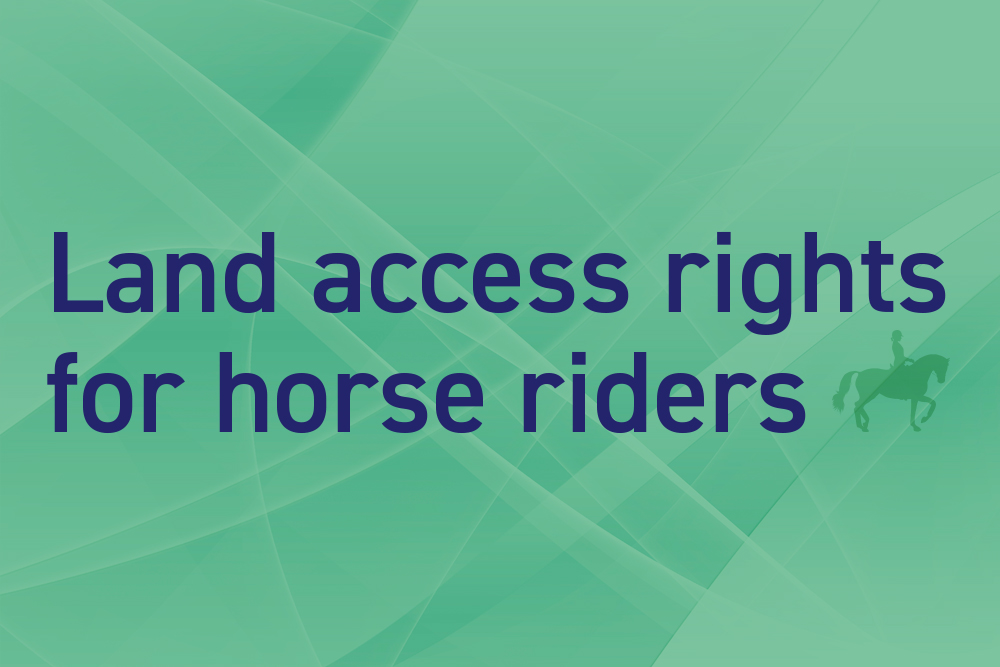Nothing beats a hack in the countryside but it’s easy for the fun to be spoiled by an angry landowner complaining that they have horse riders disturbing their livestock and damaging their land. In this part of Yorkshire we are lucky enough to have two national parks on our doorstep with a range of trails and bridleways we can access with our horses. However, many bridleways are under threat of closure and if you don’t stable your horses near to the National Parks or don’t have transport to get them there, it can be difficult to find suitable places to ride off-road and away from the ever increasing flow of traffic. Therefore, it is more important than ever before to understand your rights of access over land as a horse rider and to know how to go about dealing with any disputes that may unfortunately arise.
Under highways law, horses are permitted to be ridden or driven on all roads except motorways. With an increase in traffic and the speed of vehicles over the last few years this is not ideal because of the risk of injury to horse, rider and other road users. However, even in the most remote areas, some form of road use is often necessary to access off-road hacking.
Once off the road, horses are permitted on some (but contrary to popular belief, not all) public rights of way. You may ride or lead a horse on a designated bridleway. However, horse drawn carriages are not permitted on bridleways. Often, riders will encounter cyclists using bridleways. They are just entitled to use bridleways as horses are, although they must give way to horse riders and walkers.
When riding on a bridleway or byway, make sure you stick to the designated path, unless you are on land which has designated open access land for horses. You can check whether land is open access by referring to an up to date Ordinance Survey map or by checking the Definitive Map. This is a legal record of all public rights of way in England and Wales. It is kept by the local highways authority and may be viewed in person at your local Council offices or on Council websites, where available. Bridleways are normally a linear line of access usually wide enough for two users (equine or non-equine) to pass each other on the legally defined line. In the event that you reach a part of the bridleway where you cannot see a defined line beaten in the ground, stick to your original line. Deviating from it could be costly. You could be sued by the landowner for trespass and have to pay a hefty bill in damages. It will be much cheaper in this case to heed your instructor’s advice about sticking to your line and maintaining straightness in your horse!
You are also permitted to blow away the cobwebs on common land or beaches and estuaries, subject to bylaws and any conservation restrictions. It is important that you take the time to read any bylaws displayed at the entrance to common land before you access it and to ensure that you clarify any bylaws that you don’t understand with the keeper of the common land, whose details should be displayed on the bylaw notices. You should observe all bylaws displayed on the route. Ignorance is not a defence in law, so don’t be caught out because you didn’t read a sign at the start of your ride.
Importantly, wherever you ride, ensure that you exercise common sense and respect the landowner who has allowed you the privilege of riding across their land. Farmers and other landowners depend on their land for their livelihood, so keep this in mind when you are riding out. Make sure you ride slowly past all livestock and ensure that you leave all gates as you find them. Spending some time at home schooling your horse to stand and to turn properly at gates is time well invested. Resist the temptation to jump hedges, fences and walls without the landowner’s permission. If you cause damage to them, you may be liable to pay compensation to the owner for this and to foot the bill for the repairs. Better to save your money for your British Eventing entry fees in the spring than to spend them fixing someone’s wall.
Be aware of the ground conditions as well. Stick to walk if you think that faster paces might churn up the ground. This is also classed as damage to land and you could be held legally liable, especially if churning up the ground causes damage to a farmer’s crops. Do not ride on crops or cultivated agricultural land unless you have access through this via a designated public right of way or the landowner’s permission. Tempting as it may be, stubble fields are not fair game for an illicit gallop! The field may have recently been sown with a new crop and you could be held liable for any damage to that crop. For similar reasons, it is also best to avoid riding across conservation or heritage areas wherever possible.
Ultimately, if you know your rights and ride responsibly, all parties can enjoy the wonderful, world famous countryside that we are privileged to have around us without entering into conflict or incurring unnecessary expense.
Link to the Definitive Map for North Yorkshire: https://www.northyorks.gov.uk/definitive-map-public-rights-way
Link to the Definitive Map for the East Riding of Yorkshire: http://www2.eastriding.gov.uk/leisure/countryside-and-walks/public-rights-of-way/definitive-map/
Link to the Definitive Map for City of York: https://www.york.gov.uk/info/20120/public_rights_of_way/1217/the_definitive_map



